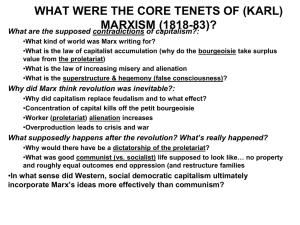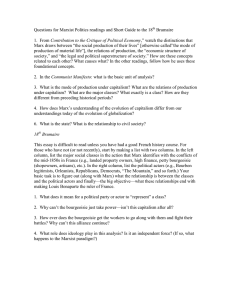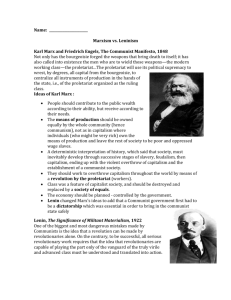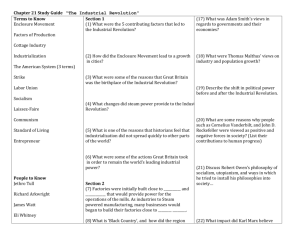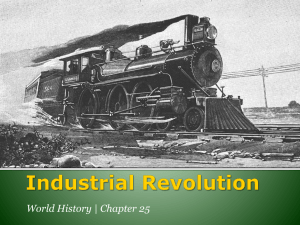I. Causes of the Industrial Revolution
advertisement
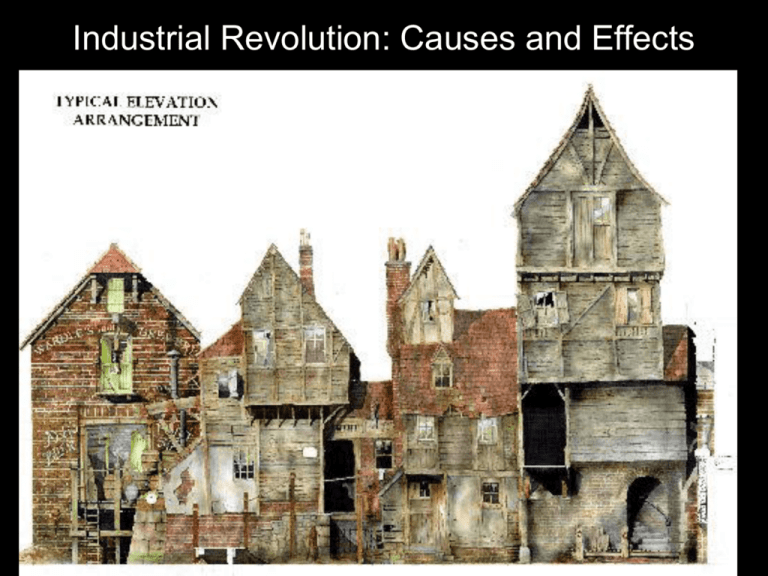
Industrial Revolution: Causes and Effects I. Causes of the Industrial Revolution The Industrial Revolution began in Great Britain in the 1780s for several reasons: 1. Agricultural improvements – expansion of farmland, good weather, improved transportation, new crops such as potatoes increased food supply led to increased population 2. Enclosure movement – landowners fenced off common lands, forcing peasants to move to cities and towns to find work; meant there was a large supply of available workers in cities; remaining farms were larger, more efficient than before 3. Laissez-faire economics – large amounts of money available for investment 4. Natural resources – rivers, coal, iron ore 5. Markets – colonies would purchase goods created in Great Britain New technologies led to better cotton cloth production, more efficient use of coal, and the invention of the steam engine which was used to power railroads, steamships, and factory production. Population of Europe doubled between 1750 and 1850 Thomas Malthus proposed that increased food supplies lead to population growth, but if the population grows too quickly it can lead to famine, disease, and war The potato famine in Ireland killed 1 million Irish and caused 1 million more to move to America II. Effects on the Physical Environment With workers moving from the country to the cities, urban areas grew and become overcrowded. Population of London, 1800 = 960,000 Population of London, 1900 = 6,500,000 Cholera and other diseases spread rapidly in crowded cities, killing thousands. People thought cholera was spread by “bad air,” but they finally realized it spread through water contaminated by waste. Citizens began to ask their governments to do something about housing, public health, and sanitation. Governments organized inspectors to monitor public health and housing. New buildings had to have running water and drainage systems. Systems were put in place to store clean water and carry it into cities, then to drain wastewater to disposal sites far from cities. III. Effects on the Social Environment The old system of commercial capitalism had been based on trade, but this new industrial capitalism was based on production This led to the evolution of both an industrial middle class (managers and owners) and an industrial working class (factory workers). The jobs performed by the working class were often demanding and dangerous People worked long hours in bad conditions and lived in crowded slums. Some reformers wanted to work from within the system to get shorter hours, better benefits, and safer working conditions. Workers formed unions then tried to get their employers to negotiate with union representatives (collective bargaining). To pressure employers into negotiating, workers could stop working until their demands were met (called a “strike.”) Other reformers wanted to replace industrial capitalism with socialism, based on the ideas of Karl Marx. Karl Marx and Frederick Engels in 1848 published The Communist Manifesto. Marx believed human history was one long struggle between the oppressors (bourgeoisie) and the oppressed (proletariat). In the capitalist system, the bourgeoisie owned the means of production. Marx thought the proletariat would rebel and form a dictatorship, taking control of the means of production. This would create a society without social classes. Women had few rights in the early 1800s; they were defined by their family roles and were legally and economically dependent on men. Feminism (movement for women’s rights) began during the Enlightenment. Women fought for the right to own property, attend universities, and enter occupations dominated by men. Some women began to demand suffrage (right to vote), but few nation allowed women to vote before 1914.

